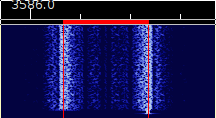all signals shown in x2 waterfall mode, tick
marks at 100 Hz intervals, waterfall palette is "blue-2"
General Description
RTTY has been used by radio amateurs since the 1950s. Initially an
electromechanical system designed for use on telephone wires, it
was not conceived as a radio system, and could not be used by
radio until the development of the Ratio Detector during the
1939-1945 war. RTTY (the name means simply Radio Teletype) uses
FSK to avoid noise on the transmission path, but requires high
power and is still prone to propagation effects, especially
selective fading and multi-path timing.
Early RTTY equipment used separate oscillators for each of the
tones, and so could produce very wide key clicks, requiring
extra filters. Modern software uses phase coherent switching
between tones, which somewhat improves the signal bandwidth.
With no error correction, and a start-stop system that is
prone to false starts on noise, RTTY is not the best mode for
amateur use. However, it is easy to use, easy to tune, fast,
tolerant of drift, and is widely used for contesting for these
reasons alone. A linear transmitter is not required.
Protocol
RTTY is an unconnected, manually controlled message asynchronous
character asynchronous simplex chat mode, used without Forward
Error Correction. The most widely used and default calling mode is
RTTY 45 (45.45 baud). Other less common speeds are 50 baud and 75
baud. The shift is usually 170 Hz, with the upper tone used for
idle condition (MARK). Commercial systems operate 425 or 850Hz
shift.
Coding and Character Set
The ITA-2 character set is used. This has two 'shifts', one for
letters, the other for figures and punctuation, a total of 60
characters. There is no lower case. Modulation is direct 2-FSK,
one data bit per symbol. Each character is transmitted serially,
preceded by an equal length start bit and followed by a stop bit
of the opposite sense at least 1.5 data bits long. Receiver
synchronism is from the leading edge of the start bit and
independently timed from there.
Operating Parameters
| Mode |
Symbol Rate |
Typing Speed1 |
Duty Cycle2 |
Bandwidth3 |
ITU Designation4 |
| RTTY 455 |
45.45 baud |
6.0 cps (60 wpm) |
100% |
270 Hz |
270HF1B |
| RTTY 50 |
50.0 baud |
6.6 cps (66 wpm) |
100% |
270 Hz |
270HF1B |
| RTTY 75 |
75.0 baud |
10.0 cps (100 wpm) |
100% |
370 Hz |
370HF1B |
Notes:
1. WPM is based on an average 5 characters per word, plus word
space.
2. Transmitter average power output relative to a constant carrier
of the same PEP value.
3. This is the "Necessary Bandwidth" as defined by the ITU.
4. A summary of the ITU Designation system can be found at http://en.wikipedia.org/wiki/Types_of_radio_emissions
5. Default and normal calling mode.

